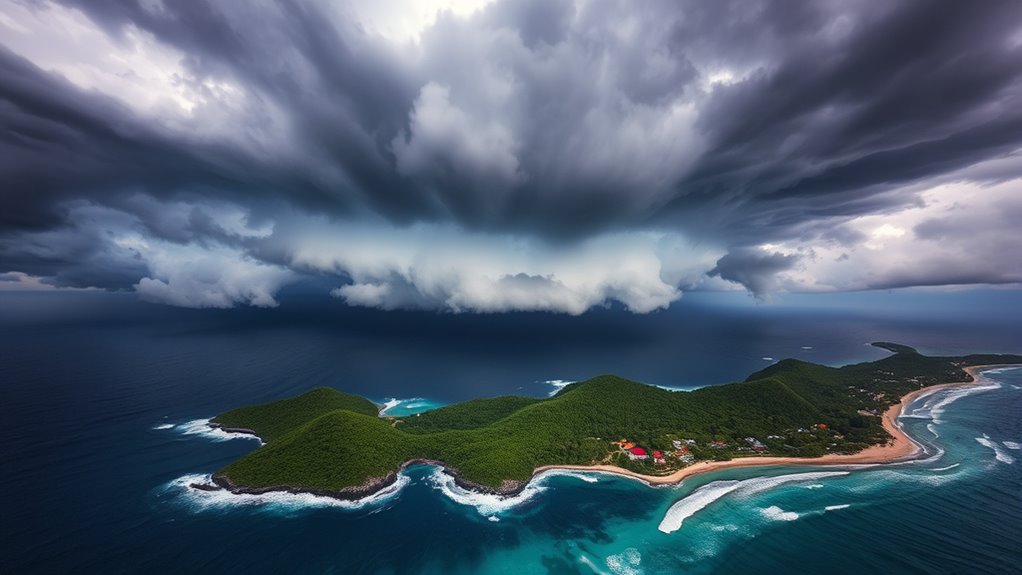To be cyclone-ready in the Indian Ocean islands, focus on developing strong disaster plans with early warning systems, evacuation routes, and clear communication. Strengthen infrastructure by building cyclone-resistant structures and protecting key facilities. Engage your community through awareness campaigns, local leaders, and inclusive training. Stay informed with reliable alerts and educate everyone about safety steps. Taking these actions now helps minimize damage and speeds recovery—exploring further will show you how to implement these strategies effectively.
Key Takeaways
- Develop comprehensive disaster preparedness plans with early warning systems, evacuation routes, and community involvement.
- Invest in cyclone-resistant infrastructure, including reinforced buildings and protected critical facilities.
- Educate communities on cyclone warning levels and safety procedures through targeted information campaigns.
- Strengthen local social networks and support groups to enhance collective response and resilience.
- Conduct regular drills and training to improve community readiness and response capabilities.

As cyclones become more frequent and intense in the Indian Ocean, the island nations in this region must stay vigilant and prepared. Your ability to respond quickly and effectively can mean the difference between safety and disaster. Developing robust disaster preparedness plans isn’t just a government responsibility; it’s something every community member should actively participate in. These plans should include early warning systems, evacuation routes, and clear communication channels. When everyone understands their roles and knows what to do, the community’s resilience increases. You should regularly participate in drills and training sessions that simulate cyclone scenarios, so responses become second nature when real storms threaten.
Stay prepared with disaster plans, early warnings, and drills to protect your community from cyclones.
Building community resilience is essential in minimizing cyclone impacts. Resilience isn’t just about bouncing back after a disaster but about reducing vulnerabilities beforehand. Local knowledge and strong social networks serve as indispensable tools in this effort. For example, knowing which homes are most at risk, understanding local safe zones, and establishing community support groups can make a big difference. Engaging local leaders, women, and youth ensures a broad-based approach that strengthens community bonds and encourages everyone to contribute. When community members work together, sharing resources and information, they create a united front that withstands the storm’s effects. Incorporating textile art techniques such as visual storytelling and community quilts can also be used to spread awareness and educate residents about cyclone safety.
Investing in infrastructure is another key element of cyclone readiness. Your government should prioritize constructing cyclone-resistant buildings and reinforcing critical facilities like hospitals and schools. These structures can withstand high winds and flooding, protecting lives and essential services. Meanwhile, households should secure their homes—installing storm shutters, elevating electrical systems, and reinforcing roofs—to reduce damage. Proper waste management and drainage systems also help prevent flooding, which is often a devastating aftermath of cyclones.
Effective disaster preparedness also involves education. You need to stay informed about cyclone alerts issued by meteorological agencies and understand the meaning of different warning levels. Sharing this knowledge within your community ensures everyone knows when to take action. Information campaigns using local languages and accessible formats can reach even the most vulnerable populations. The more informed and prepared you are, the quicker your community can mobilize when a cyclone approaches.
Ultimately, cyclone readiness in the Indian Ocean islands hinges on proactive planning, strong community resilience, and continuous education. Your participation in preparedness activities, combined with efforts to improve infrastructure and foster community cooperation, creates a safer environment for everyone. While no system can eliminate the threat of cyclones, these measures greatly reduce their destructive potential, helping you and your community survive and recover more swiftly when storms strike.
Frequently Asked Questions
How Do Local Communities Prepare for Cyclones?
You prepare for cyclones by participating in community drills to practice safety procedures and emergency responses. You also reinforce infrastructure resilience by securing buildings, trimming trees around homes, and ensuring drainage systems work properly. Staying informed through local alerts and having an emergency kit ready are essential. These proactive steps help you and your community stay safe and minimize damage when a cyclone strikes.
What Is the History of Cyclone Impacts in These Islands?
You might think these islands have learned their lesson, but historical patterns show they face recurring cyclone impacts. Impact case studies reveal devastating floods, destruction, and loss of life that often strike with little warning. Ironically, despite repeated warnings and warnings, communities remain vulnerable. Over the years, the pattern persists, reminding us that past experiences haven’t fully prepared these islands for the fury of nature’s most powerful storms.
Are There Specific Early Warning Systems in Place?
Yes, you’re protected by specific early warning systems that rely on satellite monitoring to track cyclones precisely. When a threat is detected, authorities send out public alerts through sirens, mobile notifications, and media broadcasts, ensuring you get timely information. These systems help you prepare and stay safe by providing vital updates before the cyclone reaches land, giving you the chance to take necessary precautions.
How Do Cyclone Seasons Vary Across Different Islands?
Like changing tides, cyclone seasons differ across islands due to climate variability. You’ll find that some regions face peak cyclone activity between November and April, while others experience it from June to September. Seasonal forecasting helps predict these patterns, but you should stay alert, as climate variability can shift these windows unexpectedly. Knowing each island’s cyclone season guarantees you’re better prepared for when storms may strike, like a dance in the stormy weather.
What Role Do International Agencies Play in Cyclone Preparedness?
International agencies play a crucial role in cyclone preparedness by providing international aid and disaster coordination support. They help you develop early warning systems, guarantee timely evacuation plans, and supply essential resources. These agencies coordinate efforts among local governments and organizations, enhancing response efficiency. Their involvement ensures you’re better prepared, reducing risks and damages during cyclones, ultimately safeguarding your community and saving lives through extensive disaster management strategies.
Conclusion
So, here you are, thinking you’ve got everything under control, even as the Indian Ocean’s whispers of storms grow louder. Ironically, your biggest strength—your preparedness—might just be what saves you from the chaos. But don’t get too comfortable; nature’s unpredictable. While you brace for the next cyclone, remember that sometimes, it’s the very readiness you’ve built that keeps you one step ahead of disaster—until Mother Nature decides to surprise you again.










